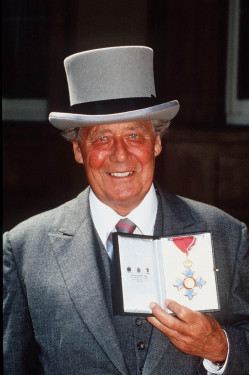
Today marks the birth of a legend who made a significant impact to Essex County Cricket Club and cricket on the whole.
Trevor Bailey CBE was born in Westcliff-on-Sea on Essex 3 December 1923 and made his first-class debut at the age of 22 in September 1945.
He later tragically died during a house fire in 2011 and will be forever remembered by the Club for his service on and off the field of play.
Essex Career Stats (1946-1967)
Debut: 18 May 1946 v Derbyshire at Valentines’ Park, Ilford
Appearances: 482
Runs: 21,460
First Class Average: 34.50
Highest Score: 205 v Sussex at Eastbourne in 1947
Centuries: 22
Fifties: 119
Wickets: 1,593 @21.99
10 wickets in an innings: 10
5 wickets in an innings: 91
Catches: 320
Trevor was one of the finest cricketers to have donned an Essex sweater and will be forever remembered for his exploits on behalf of the county both on and off the field.
Only Morris Nichols and Peter Smith claimed more wickets for Essex but Bailey scored 5,000 runs more than either of them.
He captained the Club from 1961 to 1966 and in addition to his on-field achievements, he also acted as Assistant Secretary, and then Secretary of the Club from 1955 to 1965.
He proved to be England’s leading all-rounder during the 1950’s when English cricket enjoyed eminence during the decade.
Trevor joined the Royal Marines upon leaving school and was demobbed in 1946 playing his first match for Essex in May that year at Ilford against Derbyshire when he opened the batting and bowling.
He went up to Cambridge the following year and played for the county during the holidays during which time he recorded 205 against Sussex at Eastbourne, which was to prove the highest score of a first-class career that, in total, saw the right-hander strike 28 centuries and 150 fifties aggregating 28,641 runs at an average of 33.42. He also held 426 catches.
Trevor’s statistical contribution to Essex cricket can speak for itself but no less valuable to those who played with him was the enjoyment of time spent in his company – Doug Insole
Trevor was one of the great all-rounders of English cricket at a time when England enjoyed their most successful in Test cricket and for a period, was just about the best fast bowler in England when his right-arm fast-medium pace and prowess brought him 2,082 first-class wickets @ 23.13 from his 682 matches with the telling ingredient of thirteen instances of 10 or more wickets in a match.
His best match return was 14 for 130 against Hampshire at Romford in 1957 whilst he also recorded five or more wickets in an innings on 110 occasions – an extraordinary achievement.
In 1949 at Clacton, he took all ten Lancashire wickets in an innings (10-90) and one year later, playing against Glamorgan at Newport, he claimed a hat-trick. Yet on both occasions, he finished on the losing side.
He achieved the season’s double of 1,000 runs and 100 wickets eight times whilst he was also a wonderful fielder at slip or in the gully. In 1959, he scored 2,000 runs and took 100 wickets and remains the only cricketer to have achieved this record in post-war cricket.
Bailey went on five-Test tours, the first in 1950 to Australia in a year that saw him named Wisden Cricketer of the Year. He produced a series of headline performances including a number for a defiant approach and application.
His 68 at Brisbane in 1958-59 took him over 7 and a half hours whilst against Pakistan at Trent Bridge in 1954, he contributed 27 to a fifth-wicket stand of 192 while Denis Compton (278) ran amok. Another obdurate performance came against South Africa at Headingley in 1955 when he occupied the crease for two hours in making 8, once refraining for 79 minutes from scoring a run. Yet he could bat with flair when he felt the occasion demanded.
By the time he left the international arena, he had scored 2,290 Test runs @ 29.74, taken 132 wickets @29.21, and held 32 catches in his 61 Test appearances.
He played for Essex for a further nine years, in six of which he captained the county before retiring when he was in his 44th year.
But while his performances on the field are the stuff of legends, some of his greatest contributions for his beloved Essex stemmed from his efforts off it. Whilst still a player he filled the role of county secretary from 1955 to 1965 and was responsible for borrowing £10,000 from Warwickshire to purchase the county’s Chelmsford headquarters.
He was a founder member of Ilford Cricket School and on a trip to Barbados, discovered Keith Boyce who was to become such a favourite with the Essex supporters and Trevor’s powers of persuasion also saw off-spinner Jim Laker, who had made his name with England and Surrey, spend three of his twilight playing years with Essex.
Trevor was also an accomplished footballer and won an FA Amateur Cup medal with Walthamstow Avenue before 100,000 spectators at Wembley in 1952. A year later he helped his team draw with Manchester United in an FA Cup tie at Old Trafford.
Upon retirement, he developed his business pursuits and later became a director of Southend United. He also wrote on cricket and football for the Financial Times for 25 years. For many years, he was an astute and forthright summariser on BBC Radio’s Test Match Special until 1999.
Bailey’s services to cricket were recognised in the Queen’s Birthday Honours List of 1994 with the award of the CBE.
Deep into middle age, he could be found playing for Westcliff, where he lived all his life, A fierce competitor on the field of play, he imparted a tremendous generosity of spirit off it.
He lived life to the full, was a devoted family man and his dry wit and fund of stories made him a great companion and a much-sought after-dinner speaker.

Trevor receiving his CBE in the 1994 Birthday Honours for his services to cricket.
None knew him better than Doug Insole. The former Essex captain who was to become President of the Club in his latter years penned this tribute to his close friend in the Essex Year Book upon Bailey’s retirement from playing cricket.
Doug wrote: “Between 1948 and 1966 the names of Trevor Bailey and Essex were pretty well inseparable. During that time, observers of cricket and of life saw the evolution of three distinct stages in Trevor’s sporting career, and they can hardly have failed to be interested and intrigued by what they saw.
“It is commonplace to say of somebody that figures alone do not reflect his true value to the team, but in Trevor’s case, this is a particularly valid comment. Some critics are of the opinion that Trevor occasionally succumbed to the lure of figures, but among the multitude of records of various descriptions in which he features, there is hidden a vast number of performances which defy statistical analysis and which place Trevor as a cricketer, a fighter, a tactician, and a personality far above the mere consideration of averages.
“When he first played for Essex in 1946, Trevor was only just out of the ‘schoolboy wonder’ category, and it was a comparatively slight and fairly impetuous young man who spent two years at Cambridge and a further couple of years as a player and Assistant Secretary with the County sorting out the kind of role he wanted to play.
“By the time of his first trip to Australia in 1950/51, his style of play was established and there followed for him something like ten years of success in Test cricket, and the emergence not only of one of the most valuable all-rounders in English cricket history but also of a strong personality with a keen sense of humour and a fast-developing business sense.
“In the last portion of his active career, Trevor was a mature and a quite invaluable member and later, captain of the Essex team, until the recent inappropriate and rather a sad ending to a period of participation in County cricket (injuries had taken their toll) to which he had made a major contribution to the enjoyment of the game in Essex and indeed throughout the country.
“Trevor is now involved in a series of business and sporting enterprises which are likely to keep him busy for as long as he wishes. These include radio and television commentating and sports journalism so that his fans in Essex and elsewhere need not go short of Bailey provided they read the right papers and watch the appropriate channels. His testimonial raised £4,388 which should provide him with chewing gum and cigarettes for a year or two and which is some tangible appreciation of his twenty years of work as player and administrator.
“Trevor’s statistical contribution to Essex cricket can speak for itself but no less valuable to those who played with him was the enjoyment of time spent in his company, ” Doug concluded.








